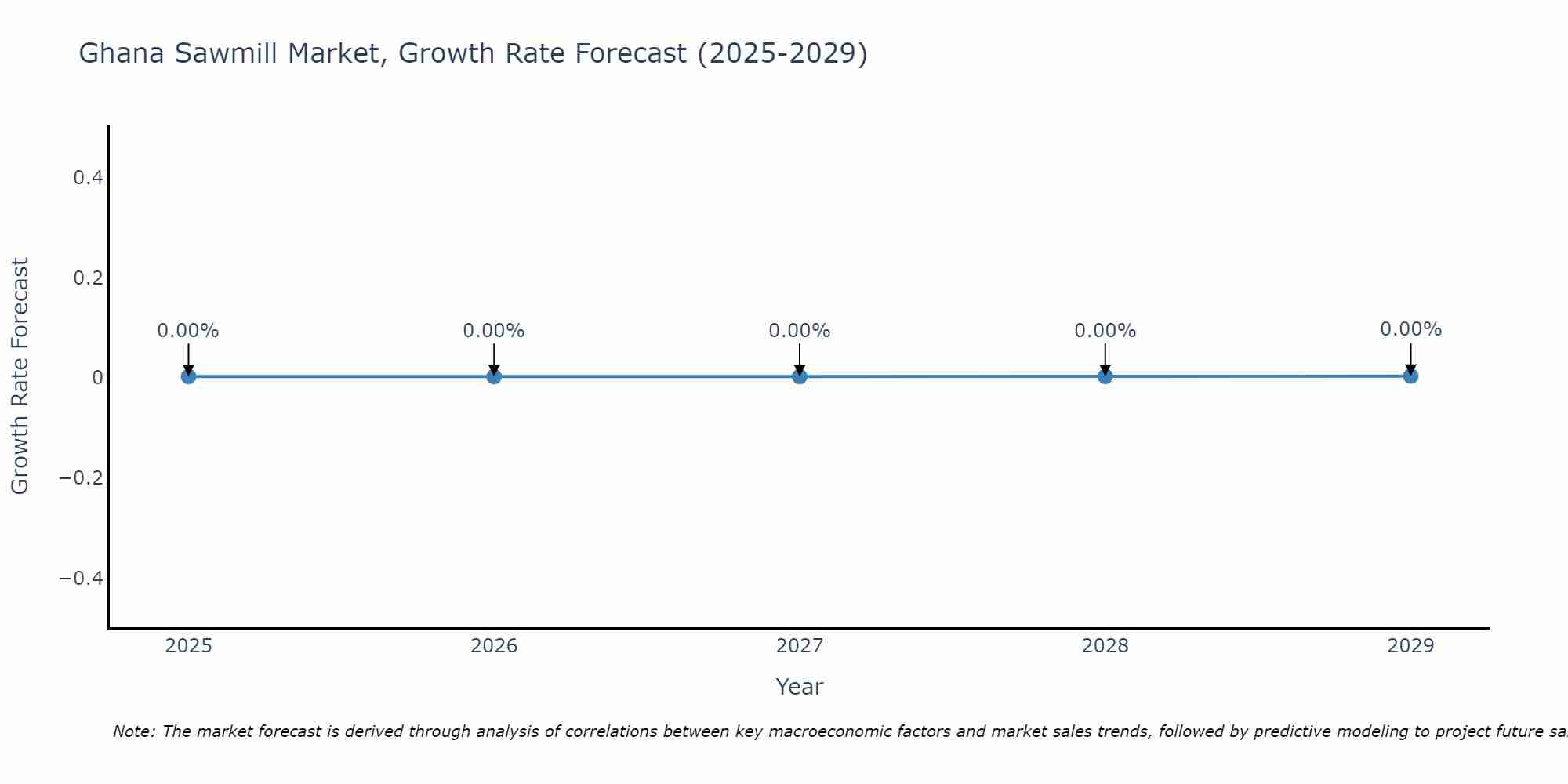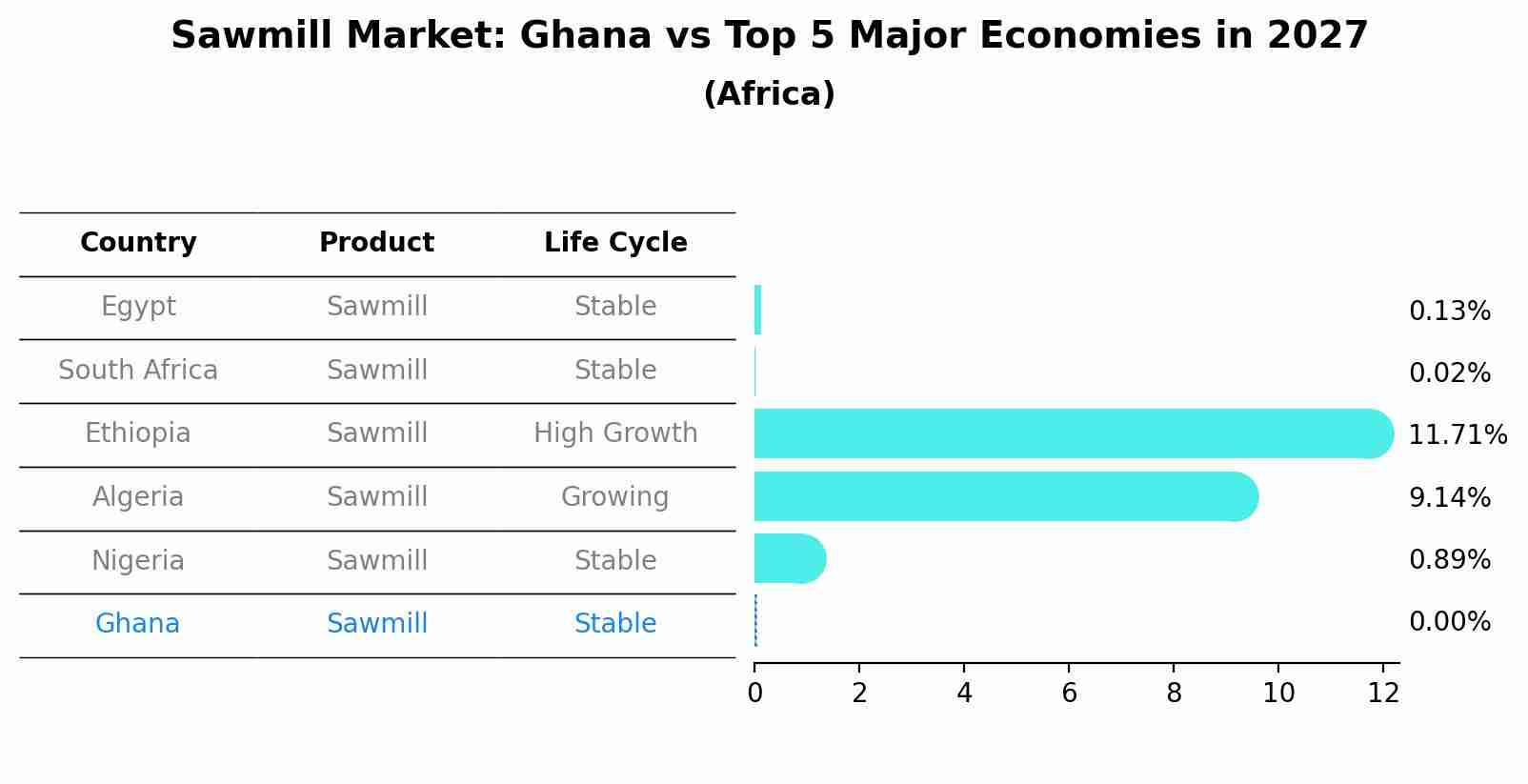Ghana Sawmill Market (2025-2031) | Outlook, Size, Growth, Analysis, Forecast, Revenue, Companies, Trends, Industry, Share, Value
| Product Code: ETC034996 | Publication Date: Oct 2020 | Updated Date: Jun 2025 | Product Type: Report | |
| Publisher: 6Wresearch | Author: Shubham Padhi | No. of Pages: 70 | No. of Figures: 35 | No. of Tables: 5 |
Ghana Sawmill Market Size Growth Rate
The Ghana Sawmill Market is likely to experience consistent growth rate gains over the period 2025 to 2029. From 0.00% in 2025, the growth rate steadily ascends to 0.00% in 2029.

Sawmill Market: Ghana vs Top 5 Major Economies in 2027 (Africa)
In the Africa region, the Sawmill market in Ghana is projected to expand at a stable growth rate of 0.00% by 2027. The largest economy is Egypt, followed by South Africa, Ethiopia, Algeria and Nigeria.

Ghana Sawmill Market Overview
The Ghana sawmill market is a key sector within the country`s forestry industry, driven by the demand for timber products both domestically and internationally. The market consists of a mix of large-scale commercial sawmills and smaller, locally-owned operations, catering to a variety of customers ranging from construction companies to furniture manufacturers. Sustainable forestry practices are increasingly being emphasized in Ghana, leading to a shift towards certified timber products. Challenges in the market include illegal logging activities, inefficient processing techniques, and limited access to modern equipment and technology. However, with growing awareness of environmental issues and the implementation of stricter regulations, the Ghana sawmill market is expected to evolve towards more sustainable practices and continue to play a significant role in the country`s economy.
Ghana Sawmill Market Trends
The Ghana sawmill market is experiencing a trend towards sustainable practices and technology adoption. With an increased awareness of environmental issues, sawmill operators are implementing measures to reduce waste and improve efficiency in their operations. There is also a growing demand for certified sustainable timber products in both domestic and international markets, leading sawmills to seek certification to meet these requirements. Additionally, the adoption of technology such as automated sawing equipment and digital tracking systems is on the rise to enhance productivity and quality control. Overall, the Ghana sawmill market is moving towards a more sustainable and technologically advanced future to meet the demands of environmentally conscious consumers and global market standards.
Ghana Sawmill Market Challenges
The Ghana sawmill market faces several challenges, including illegal logging practices leading to deforestation and environmental degradation. Inefficient and outdated equipment and technology hinder productivity and quality of output, impacting competitiveness in the global market. Lack of access to finance for sawmill operators limits their ability to invest in modernization and expansion. Additionally, inconsistent government policies and regulations create uncertainty in the market, making it difficult for sawmill businesses to plan for the long term. The industry also struggles with issues related to land tenure and disputes, which can disrupt operations and lead to delays. Addressing these challenges will require a comprehensive approach involving sustainable forestry practices, technology upgrades, financial support, and policy reforms to ensure the long-term viability of the Ghana sawmill market.
Ghana Sawmill Market Investment Opportunities
Investment opportunities in the Ghana sawmill market include the growing demand for timber products driven by population growth, urbanization, and infrastructure development in the country. Investing in modernizing existing sawmills or establishing new sawmill operations equipped with advanced technology can improve efficiency and production capacity. Additionally, there is potential for value-added products such as furniture, flooring, and construction materials to cater to both domestic and export markets. With Ghana`s abundant forest resources and government initiatives to promote sustainable forestry practices, investors can capitalize on the rising demand for high-quality wood products while contributing to the country`s economic development and environmental sustainability. Conducting thorough market research, understanding regulations, and establishing partnerships with local stakeholders are key factors for successful investments in the Ghana sawmill market.
Ghana Sawmill Market Government Policy
The government of Ghana has implemented various policies to regulate the sawmill market in the country. This includes the enforcement of the Timber Industry Development Division (TIDD) Act, which aims to promote sustainable forest management practices and ensure the legality of timber products. Additionally, the government has imposed restrictions on the export of raw timber logs to encourage local processing and value addition within the country. The Forestry Commission of Ghana also plays a key role in monitoring and regulating the operations of sawmills to prevent illegal logging and promote environmental conservation efforts. Overall, these policies are aimed at promoting sustainable practices, supporting the local timber industry, and safeguarding Ghana`s forest resources for future generations.
Ghana Sawmill Market Future Outlook
The future outlook for the Ghana Sawmill Market appears promising due to the country`s growing construction and furniture manufacturing industries. With an increasing population and urbanization trend driving the demand for housing and infrastructure development, the need for sawn timber is expected to rise steadily. Additionally, the government`s focus on promoting sustainable forestry practices and value addition in the timber industry is likely to create new opportunities for sawmill operators. However, challenges such as illegal logging, lack of modern technology, and competition from imported timber products could impact market growth. To remain competitive, sawmill operators in Ghana may need to invest in advanced machinery, adopt sustainable practices, and explore export opportunities to diversify their revenue streams in the coming years.
Key Highlights of the Report:
- Ghana Sawmill Market Outlook
- Market Size of Ghana Sawmill Market, 2024
- Forecast of Ghana Sawmill Market, 2026
- Historical Data and Forecast of Ghana Sawmill Revenues & Volume for the Period 2021 - 2031
- Ghana Sawmill Market Trend Evolution
- Ghana Sawmill Market Drivers and Challenges
- Ghana Sawmill Price Trends
- Ghana Sawmill Porter's Five Forces
- Ghana Sawmill Industry Life Cycle
- Historical Data and Forecast of Ghana Sawmill Market Revenues & Volume By Product Type for the Period 2021 - 2031
- Historical Data and Forecast of Ghana Sawmill Market Revenues & Volume By Softwood Lumber for the Period 2021 - 2031
- Historical Data and Forecast of Ghana Sawmill Market Revenues & Volume By Hardwood Lumber for the Period 2021 - 2031
- Historical Data and Forecast of Ghana Sawmill Market Revenues & Volume By Application for the Period 2021 - 2031
- Historical Data and Forecast of Ghana Sawmill Market Revenues & Volume By Construction for the Period 2021 - 2031
- Historical Data and Forecast of Ghana Sawmill Market Revenues & Volume By Furniture for the Period 2021 - 2031
- Historical Data and Forecast of Ghana Sawmill Market Revenues & Volume By Packaging and Joinery Industries for the Period 2021 - 2031
- Historical Data and Forecast of Ghana Sawmill Market Revenues & Volume By Others for the Period 2021 - 2031
- Ghana Sawmill Import Export Trade Statistics
- Market Opportunity Assessment By Product Type
- Market Opportunity Assessment By Application
- Ghana Sawmill Top Companies Market Share
- Ghana Sawmill Competitive Benchmarking By Technical and Operational Parameters
- Ghana Sawmill Company Profiles
- Ghana Sawmill Key Strategic Recommendations
Frequently Asked Questions About the Market Study (FAQs):
1 Executive Summary |
2 Introduction |
2.1 Key Highlights of the Report |
2.2 Report Description |
2.3 Market Scope & Segmentation |
2.4 Research Methodology |
2.5 Assumptions |
3 Ghana Sawmill Market Overview |
3.1 Ghana Country Macro Economic Indicators |
3.2 Ghana Sawmill Market Revenues & Volume, 2019 & 2026F |
3.3 Ghana Sawmill Market - Industry Life Cycle |
3.4 Ghana Sawmill Market - Porter's Five Forces |
3.5 Ghana Sawmill Market Revenues & Volume Share, By Product Type, 2019 & 2026F |
3.6 Ghana Sawmill Market Revenues & Volume Share, By Application, 2019 & 2026F |
4 Ghana Sawmill Market Dynamics |
4.1 Impact Analysis |
4.2 Market Drivers |
4.3 Market Restraints |
5 Ghana Sawmill Market Trends |
6 Ghana Sawmill Market, By Types |
6.1 Ghana Sawmill Market, By Product Type |
6.1.1 Overview and Analysis |
6.1.2 Ghana Sawmill Market Revenues & Volume, By Product Type, 2016 - 2026F |
6.1.3 Ghana Sawmill Market Revenues & Volume, By Softwood Lumber, 2016 - 2026F |
6.1.4 Ghana Sawmill Market Revenues & Volume, By Hardwood Lumber, 2016 - 2026F |
6.2 Ghana Sawmill Market, By Application |
6.2.1 Overview and Analysis |
6.2.2 Ghana Sawmill Market Revenues & Volume, By Construction, 2016 - 2026F |
6.2.3 Ghana Sawmill Market Revenues & Volume, By Furniture, 2016 - 2026F |
6.2.4 Ghana Sawmill Market Revenues & Volume, By Packaging and Joinery Industries, 2016 - 2026F |
6.2.5 Ghana Sawmill Market Revenues & Volume, By Others, 2016 - 2026F |
7 Ghana Sawmill Market Import-Export Trade Statistics |
7.1 Ghana Sawmill Market Export to Major Countries |
7.2 Ghana Sawmill Market Imports from Major Countries |
8 Ghana Sawmill Market Key Performance Indicators |
9 Ghana Sawmill Market - Opportunity Assessment |
9.1 Ghana Sawmill Market Opportunity Assessment, By Product Type, 2019 & 2026F |
9.2 Ghana Sawmill Market Opportunity Assessment, By Application, 2019 & 2026F |
10 Ghana Sawmill Market - Competitive Landscape |
10.1 Ghana Sawmill Market Revenue Share, By Companies, 2024 |
10.2 Ghana Sawmill Market Competitive Benchmarking, By Operating and Technical Parameters |
11 Company Profiles |
12 Recommendations |
13 Disclaimer |
- Single User License$ 1,995
- Department License$ 2,400
- Site License$ 3,120
- Global License$ 3,795
Search
Thought Leadership and Analyst Meet
Our Clients
Related Reports
- Germany Breakfast Food Market (2026-2032) | Industry, Share, Growth, Size, Companies, Value, Analysis, Revenue, Trends, Forecast & Outlook
- Australia Briquette Market (2025-2031) | Growth, Size, Revenue, Forecast, Analysis, Trends, Value, Share, Industry & Companies
- Vietnam System Integrator Market (2025-2031) | Size, Companies, Analysis, Industry, Value, Forecast, Growth, Trends, Revenue & Share
- ASEAN and Thailand Brain Health Supplements Market (2025-2031) | Strategy, Consumer Insights, Analysis, Investment Trends, Opportunities, Growth, Size, Share, Industry, Revenue, Segments, Value, Segmentation, Supply, Forecast, Restraints, Outlook, Competition, Drivers, Trends, Demand, Pricing Analysis, Competitive, Strategic Insights, Companies, Challenges
- ASEAN Bearings Market (2025-2031) | Strategy, Consumer Insights, Analysis, Investment Trends, Opportunities, Growth, Size, Share, Industry, Revenue, Segments, Value, Segmentation, Supply, Forecast, Restraints, Outlook, Competition, Drivers, Trends, Demand, Pricing Analysis, Competitive, Strategic Insights, Companies, Challenges
- Europe Flooring Market (2025-2031) | Outlook, Share, Industry, Trends, Forecast, Companies, Revenue, Size, Analysis, Growth & Value
- Saudi Arabia Manlift Market (2025-2031) | Outlook, Size, Growth, Trends, Companies, Industry, Revenue, Value, Share, Forecast & Analysis
- Uganda Excavator, Crane, and Wheel Loaders Market (2025-2031) | Strategy, Consumer Insights, Analysis, Investment Trends, Opportunities, Growth, Size, Share, Industry, Revenue, Segments, Value, Segmentation, Supply, Forecast, Restraints, Outlook, Competition, Drivers, Trends, Demand, Pricing Analysis, Competitive, Strategic Insights, Companies, Challenges
- Rwanda Excavator, Crane, and Wheel Loaders Market (2025-2031) | Strategy, Consumer Insights, Analysis, Investment Trends, Opportunities, Growth, Size, Share, Industry, Revenue, Segments, Value, Segmentation, Supply, Forecast, Restraints, Outlook, Competition, Drivers, Trends, Demand, Pricing Analysis, Competitive, Strategic Insights, Companies, Challenges
- Kenya Excavator, Crane, and Wheel Loaders Market (2025-2031) | Strategy, Consumer Insights, Analysis, Investment Trends, Opportunities, Growth, Size, Share, Industry, Revenue, Segments, Value, Segmentation, Supply, Forecast, Restraints, Outlook, Competition, Drivers, Trends, Demand, Pricing Analysis, Competitive, Strategic Insights, Companies, Challenges
Industry Events and Analyst Meet
Whitepaper
- Middle East & Africa Commercial Security Market Click here to view more.
- Middle East & Africa Fire Safety Systems & Equipment Market Click here to view more.
- GCC Drone Market Click here to view more.
- Middle East Lighting Fixture Market Click here to view more.
- GCC Physical & Perimeter Security Market Click here to view more.
6WResearch In News
- Doha a strategic location for EV manufacturing hub: IPA Qatar
- Demand for luxury TVs surging in the GCC, says Samsung
- Empowering Growth: The Thriving Journey of Bangladesh’s Cable Industry
- Demand for luxury TVs surging in the GCC, says Samsung
- Video call with a traditional healer? Once unthinkable, it’s now common in South Africa
- Intelligent Buildings To Smooth GCC’s Path To Net Zero


















